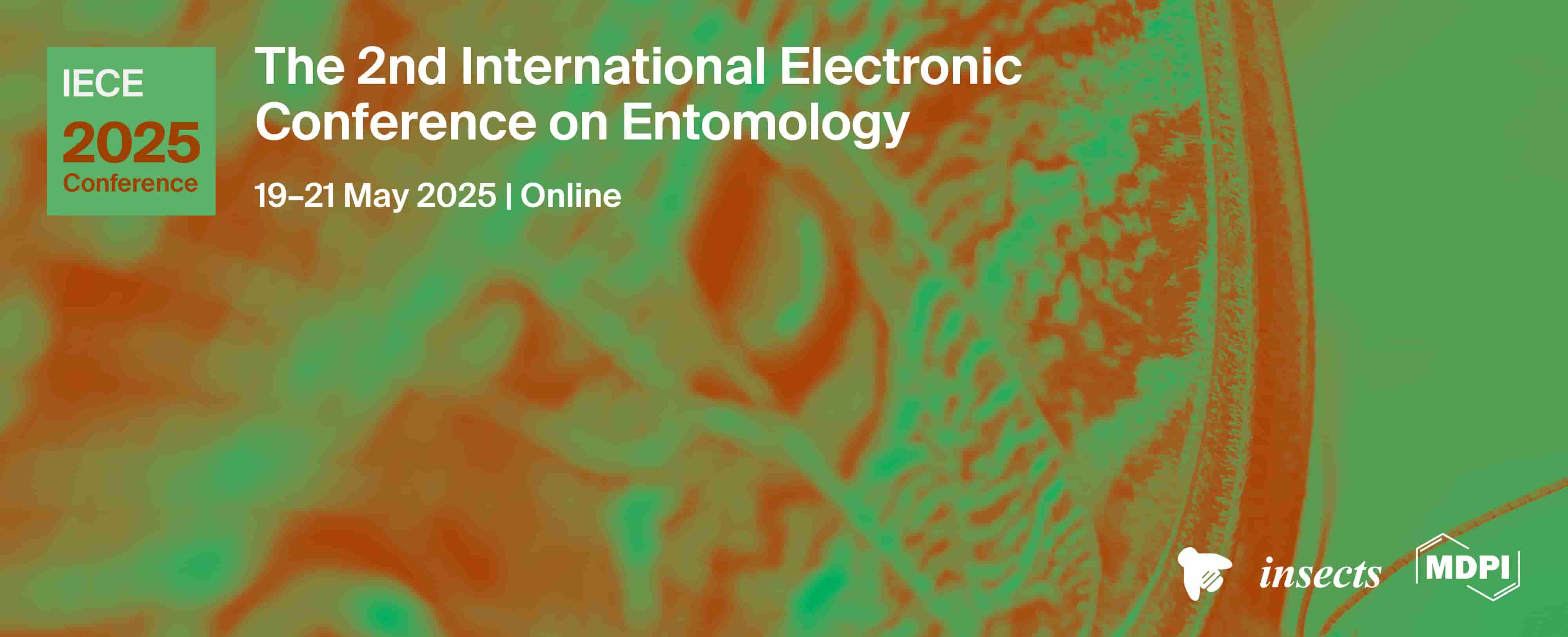-
 Integrated Pest Management Strategies to Control Varroa Mites and Their Effect on Viral Loads in Honey Bee Colonies
Integrated Pest Management Strategies to Control Varroa Mites and Their Effect on Viral Loads in Honey Bee Colonies -
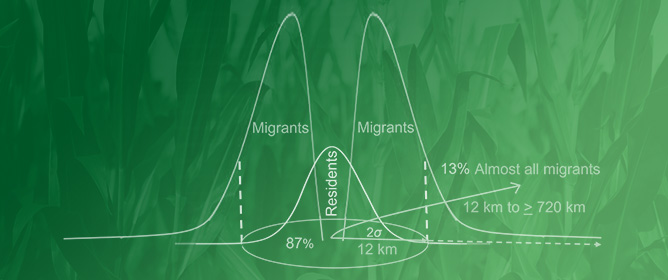 Critical Facets of European Corn Borer Adult Movement Ecology Relevant to Mitigating Field Resistance to Bt-Corn
Critical Facets of European Corn Borer Adult Movement Ecology Relevant to Mitigating Field Resistance to Bt-Corn -
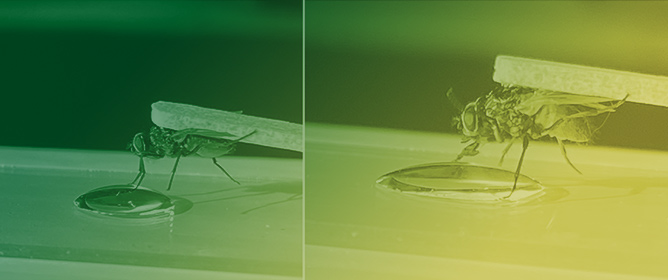 Use of the Proboscis Extension Response Assay to Evaluate the Mechanism of House Fly Behavioral Resistance to Imidacloprid
Use of the Proboscis Extension Response Assay to Evaluate the Mechanism of House Fly Behavioral Resistance to Imidacloprid
Journal Description
Insects
Insects
is an international, peer-reviewed, open access journal on entomology published monthly online by MDPI.
- Open Access— free for readers, with article processing charges (APC) paid by authors or their institutions.
- High Visibility: indexed within Scopus, SCIE (Web of Science), PubMed, PMC, PubAg, and other databases.
- Journal Rank: JCR - Q1 (Entomology) / CiteScore - Q1 (Insect Science)
- Rapid Publication: manuscripts are peer-reviewed and a first decision is provided to authors approximately 17 days after submission; acceptance to publication is undertaken in 2.9 days (median values for papers published in this journal in the second half of 2023).
- Recognition of Reviewers: reviewers who provide timely, thorough peer-review reports receive vouchers entitling them to a discount on the APC of their next publication in any MDPI journal, in appreciation of the work done.
Impact Factor:
3.0 (2022);
5-Year Impact Factor:
3.1 (2022)
Latest Articles
CRISPR/Cas9-Based Functional Characterization of SfUGT50A15 Reveals Its Roles in the Resistance of Spodoptera frugiperda to Chlorantraniliprole, Emamectin Benzoate, and Benzoxazinoids
Insects 2024, 15(5), 314; https://doi.org/10.3390/insects15050314 (registering DOI) - 26 Apr 2024
Abstract
UDP-glycosyltransferases (UGTs) are a diverse superfamily of enzymes. Insects utilize uridine diphosphate-glucose (UDP-glucose) as a glycosyl donor for glycosylation in vivo, involved in the glycosylation of lipophilic endosymbionts and xenobiotics, including phytotoxins. UGTs act as second-stage detoxification metabolizing enzymes, which are essential for
[...] Read more.
UDP-glycosyltransferases (UGTs) are a diverse superfamily of enzymes. Insects utilize uridine diphosphate-glucose (UDP-glucose) as a glycosyl donor for glycosylation in vivo, involved in the glycosylation of lipophilic endosymbionts and xenobiotics, including phytotoxins. UGTs act as second-stage detoxification metabolizing enzymes, which are essential for the detoxification metabolism of insecticides and benzoxazine compounds. However, the UGT genes responsible for specific glycosylation functions in S. frugiperda are unclear at present. In this study, we utilized CRISPR/Cas9 to produce a SfUGT50A15-KO strain to explore its possible function in governing sensitivity to chemical insecticides or benzoxazinoids. The bioassay results suggested that the SfUGT50A15-KO strain was significantly more sensitive to chlorantraniliprole, emamectin benzoate, and benzoxazinoids than the wild-type strains. This finding suggests that the overexpression of the SfUGT50A15 gene may be linked to S. frugiperda resistance to pesticides (chlorantraniliprole and emamectin benzoate) as well as benzoxazinoids (BXDs).
Full article
(This article belongs to the Section Insect Pest and Vector Management)
Open AccessArticle
Upf2-Mediated Nonsense-Mediated Degradation Pathway Involved in Genetic Compensation of TrpA1 Knockout Mutant Silkworm (Bombyx mori)
by
Dong-Yue Wang, Juan Zhu, Yi-Zhong Zhang, Qian-Yi Cui, Shan-Shan Wang, Yang-Wei Ning and Xing-Jia Shen
Insects 2024, 15(5), 313; https://doi.org/10.3390/insects15050313 - 26 Apr 2024
Abstract
Genetic mutations leading to premature termination codons are known to have detrimental effects. Using the Lepidoptera model insect, the silkworm (Bombyx mori), we explored the genetic compensatory response triggered by mutations with premature termination codons. Additionally, we delved into the molecular
[...] Read more.
Genetic mutations leading to premature termination codons are known to have detrimental effects. Using the Lepidoptera model insect, the silkworm (Bombyx mori), we explored the genetic compensatory response triggered by mutations with premature termination codons. Additionally, we delved into the molecular mechanisms associated with the nonsense-mediated mRNA degradation pathway. CRISPR/Cas9 technology was utilized to generate a homozygous bivoltine silkworm line BmTrpA1−/− with a premature termination. Transcript levels were assessed for the BmTrpA paralogs, BmPyrexia and BmPainless as well as for the essential factors Upf1, Upf2, and Upf3a involved in the nonsense-mediated mRNA degradation (NMD) pathway. Upf2 was specifically knocked down via RNA interference at the embryonic stage. The results comfirmed that the BmTrpA1 transcripts with a 2-base deletion generating a premature termination codon in the BmTrpA1−/− line. From day 6 of embryonic development, the mRNA levels of BmPyrexia, BmPainless, Upf1, and Upf2 were significantly elevated in the gene-edited line. Embryonic knockdown of Upf2 resulted in the suppression of the genetic compensation response in the mutant. As a result, the offspring silkworm eggs were able to hatch normally after 10 days of incubation, displaying a non-diapause phenotype. It was observed that a genetic compensation response does exist in BmTrpA1−/− B. mori. This study presents a novel discovery of the NMD-mediated genetic compensation response in B. mori. The findings offer new insights into understanding the genetic compensation response and exploring the gene functions in lepidopteran insects, such as silkworms.
Full article
(This article belongs to the Section Insect Molecular Biology and Genomics)
►▼
Show Figures
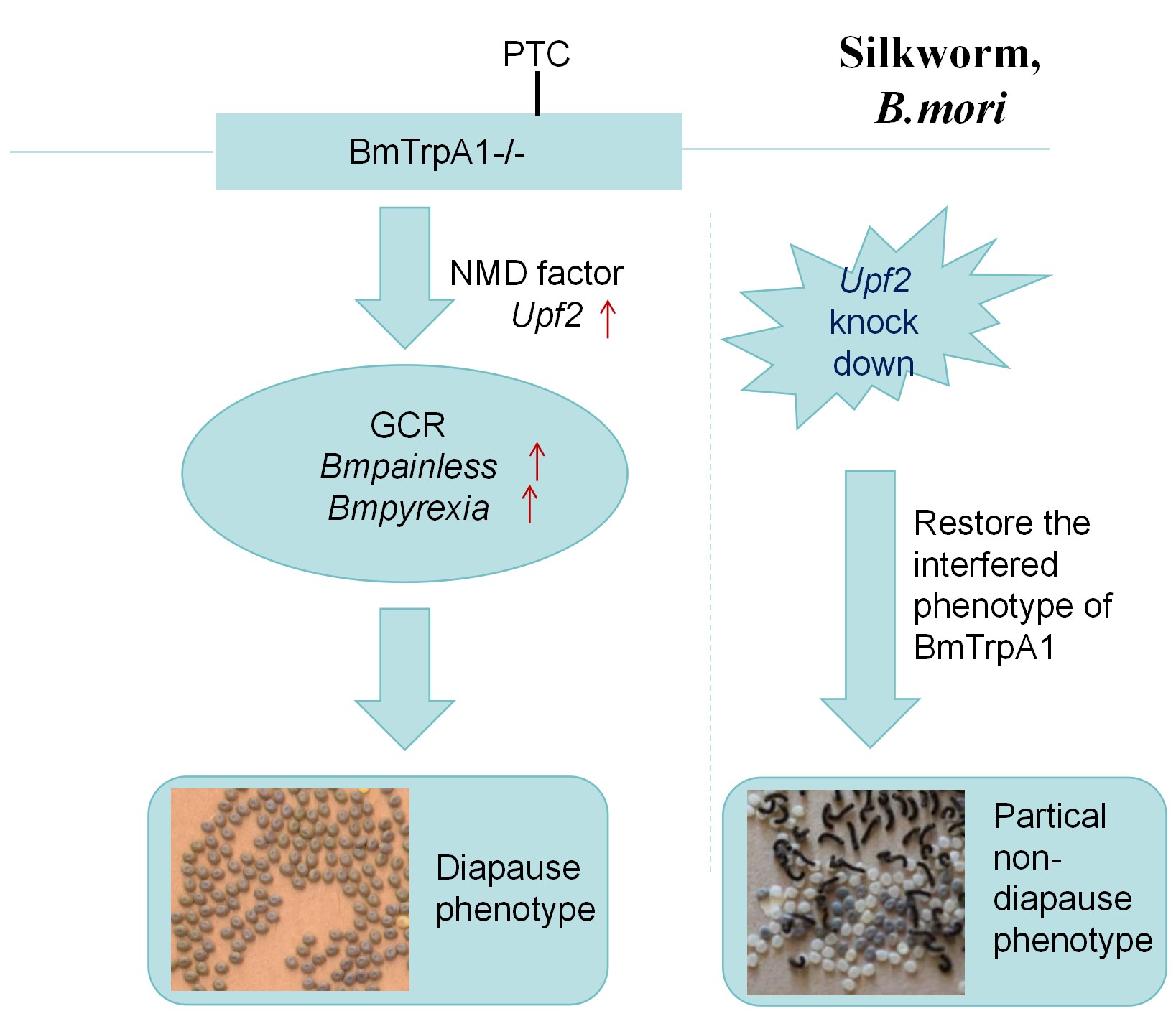
Graphical abstract
Open AccessArticle
Two Nested Inversions in the X Chromosome Differentiate the Dominant Malaria Vectors in Europe, Anopheles atroparvus and Anopheles messeae
by
Evgenia S. Soboleva, Kirill M. Kirilenko, Valentina S. Fedorova, Alina A. Kokhanenko, Gleb N. Artemov and Igor V. Sharakhov
Insects 2024, 15(5), 312; https://doi.org/10.3390/insects15050312 - 26 Apr 2024
Abstract
The Maculipennis subgroup of malaria mosquitoes includes both dominant malaria vectors and non-vectors in Eurasia. Understanding the genetic factors, particularly chromosomal inversions, that differentiate Anopheles species can provide valuable insights for vector control strategies. Although autosomal inversions between the species in this subgroup
[...] Read more.
The Maculipennis subgroup of malaria mosquitoes includes both dominant malaria vectors and non-vectors in Eurasia. Understanding the genetic factors, particularly chromosomal inversions, that differentiate Anopheles species can provide valuable insights for vector control strategies. Although autosomal inversions between the species in this subgroup have been characterized based on the chromosomal banding patterns, the number and positions of rearrangements in the X chromosome remain unclear due to the divergent banding patterns. Here, we identified two large X chromosomal inversions, approximately 13 Mb and 10 Mb in size, using fluorescence in situ hybridization. The inversion breakpoint regions were mapped by hybridizing 53 gene markers with polytene chromosomes of An. messeae. The DNA probes were designed based on gene sequences from the annotated An. atroparvus genome. The two nested inversions resulted in five syntenic blocks. Only two small syntenic blocks, which encompass 181 annotated genes in the An. atroparvus genome, changed their position and orientation in the X chromosome. The analysis of the An. atroparvus genome revealed an enrichment of gene ontology terms associated with immune system and mating behavior in the rearranged syntenic blocks. Additionally, the enrichment of DNA transposons was found in sequences homologous to three of the four breakpoint regions. This study demonstrates the successful application of the physical genome mapping approach to identify rearrangements that differentiate species in insects with polytene chromosomes.
Full article
(This article belongs to the Section Insect Molecular Biology and Genomics)
►▼
Show Figures
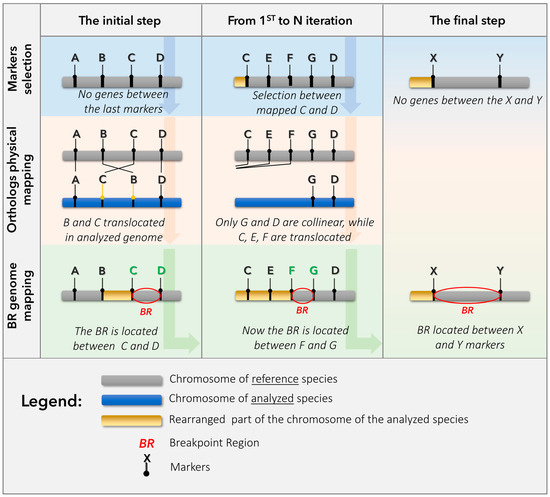
Figure 1
Open AccessArticle
Immune-Related Gene Profiles and Differential Expression in the Grey Garden Slug Deroceras reticulatum Infected with the Parasitic Nematode Phasmarhabditis hermaphrodita
by
Muhammad Hafeez, Rory Mc Donnell, Andrew Colton, Dana Howe, Dee Denver, Ruth C. Martin and Man-Yeon Choi
Insects 2024, 15(5), 311; https://doi.org/10.3390/insects15050311 - 26 Apr 2024
Abstract
The grey garden slug (Deroceras reticulatum), a common terrestrial slug native to Europe with a global distribution including North America, is commonly considered the most severe slug pest in agriculture. The nematode Phasmarhabditis hermaphrodita, which has been used in the
[...] Read more.
The grey garden slug (Deroceras reticulatum), a common terrestrial slug native to Europe with a global distribution including North America, is commonly considered the most severe slug pest in agriculture. The nematode Phasmarhabditis hermaphrodita, which has been used in the U.K. and Europe as a commercial biocontrol agent since 1994, has also recently been collected in Oregon and California and has long been considered a candidate biocontrol agent for slug management in the U.S. In this study, we report differential gene expressions in nematode-infected slugs using RNA-seq to identify slug immune-related genes against nematodes. Comparison of gene expression levels between the whole bodies of a nematode-infected slug (N-S) and an uninfected control slug (C-S) revealed that there were a total of 39,380 regulated unigenes, of which 3084 (3%) were upregulated and 6761 (6%) were downregulated at greater than 2-fold change (FC > 2) in the nematode-infected slug. To further investigate the biological functions of differentially expressed genes (DEGs), gene ontology (GO) and functional enrichment analysis were performed to map the DEGs to terms in the GO, eukaryotic ortholog groups of proteins (KOG) and Kyoto Encyclopedia of Genes and Genome Pathway (KEGG) databases. Among these DEGs, approximately 228 genes associated with immunity or immune-related pathways were upregulated 2-fold or more in the N-S compared to C-S. These genes include toll, Imd, JNK, scavenger receptors (SCRs), C-type lectins (CTLs), immunoglobulin-like domains, and JAK/STAT63 signaling pathways. From the RNA-seq results, we selected 18 genes and confirmed their expression levels by qRT-PCR. Our findings provide insights into the immune response of slugs during nematode infection. These studies provide fundamental information that will be valuable for the development of new methods of pest slug control using pathogenic nematodes in the field.
Full article
(This article belongs to the Section Insect Molecular Biology and Genomics)
►▼
Show Figures

Figure 1
Open AccessArticle
Consumption of β-Caryophyllene Increases the Mating Success of Bactrocera zonata Males (Diptera: Tephritidae)
by
Ihsan ul Haq, Sehar Fatima, Awais Rasool and Todd E. Shelly
Insects 2024, 15(5), 310; https://doi.org/10.3390/insects15050310 - 26 Apr 2024
Abstract
The peach fruit fly, Bactrocera zonata (Saunders) (Diptera: Tephritidae), is an economically important polyphagous quarantine pest of horticultural crops endemic to South and Southeast Asia. Methyl eugenol (ME), a naturally occurring phenylpropanoid, is a male attractant used to lure and (when mixed with
[...] Read more.
The peach fruit fly, Bactrocera zonata (Saunders) (Diptera: Tephritidae), is an economically important polyphagous quarantine pest of horticultural crops endemic to South and Southeast Asia. Methyl eugenol (ME), a naturally occurring phenylpropanoid, is a male attractant used to lure and (when mixed with an insecticide) annihilate the males from the wild population, a method of pest control termed the male annihilation technique (MAT). ME is reported to enhance the mating success of sterile males of Bactrocera spp., which is critical for enhancing the effectiveness of the sterile insect technique (SIT). The suppressed response of ME-treated males to ME-baited traps/devices allows the simultaneous application of the MAT and SIT, increasing the efficiency of area-wide integrated pest management (AW-IPM) programs. However, ME treatment in sterile males in SIT facilities is logistically difficult. β-caryophyllene (BCP) is a widely occurring, safer plant compound and is considered suitable for treating males in SIT facilities. Here, we demonstrate that BCP feeding enhanced B. zonata male mating success to the same extent as ME feeding. Feeding on BCP suppressed the male’s subsequent attraction to ME-baited traps, but not to the same degree as feeding on ME. The results are discussed and BCP is suggested as an alternative to ME for the concurrent use of the MAT and SIT.
Full article
(This article belongs to the Section Insect Pest and Vector Management)
►▼
Show Figures
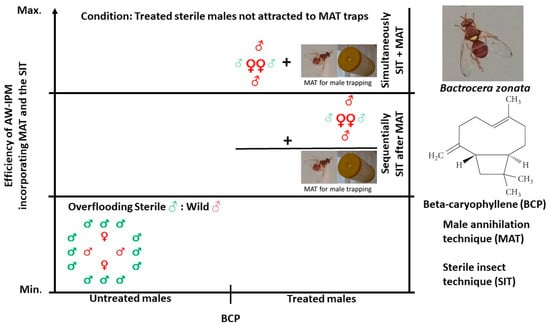
Graphical abstract
Open AccessArticle
Do Invasive Jorō Spiders (Trichonephila clavata) from Asia Avoid Eating Unpalatable Monarch Butterflies (Danaus plexippus) in North America?
by
Andrew K. Davis, Wilson Townsend Morris, Emma Hobbs and Ella Blakely
Insects 2024, 15(5), 309; https://doi.org/10.3390/insects15050309 - 25 Apr 2024
Abstract
An invasive spider from East Asia has established in the U.S. southeast (the “jorō spider,” Trichonephila clavata) and is rapidly expanding its range. Studies assessing the impact of this species are needed, including how expansive its diet is. An open question is
[...] Read more.
An invasive spider from East Asia has established in the U.S. southeast (the “jorō spider,” Trichonephila clavata) and is rapidly expanding its range. Studies assessing the impact of this species are needed, including how expansive its diet is. An open question is whether monarch butterflies, Danaus plexippus, are a potential prey item for this spider, given that jorō spiders do not coexist with monarchs in their native range. Since monarch larvae feed on milkweed, they sequester cardiac glycosides into their adult tissues, rendering them unpalatable to many predators. At sites within northeast Georgia, we staged a series of trials (n = 61) where we tossed monarchs into jorō spider webs and, for comparison, performed similar trials with another aposematic species, gulf fritillary (Agraulis vanilla), and a palatable species, tiger swallowtail (Papilio glaucus). We recorded the outcome of the trials, which included whether the spider attacked or did not attack the prey. We also conducted a visual survey during the same fall season to look for evidence of jorō spiders consuming monarchs naturally. Our findings revealed that jorō spiders avoided eating monarchs; spiders only attacked monarchs 20% of the time, which was significantly less than the attack rates of similarly sized or larger butterflies: 86% for gulf fritillaries and 58% for tiger swallowtails. Some jorō spiders even removed monarchs from their webs. From our visual surveys of the surrounding area, we found no evidence of natural monarch consumption and, in general, butterflies made up only a fraction of the jorō spider diet. We conclude that jorō spiders appear to recognize monarch butterflies as being unpalatable, even without having a prior history with the species. This invokes questions about how these spiders can immediately recognize their unpalatability without touching the butterflies.
Full article
(This article belongs to the Section Other Arthropods and General Topics)
Open AccessArticle
Water Colour Shapes Diving Beetle (Coleoptera: Dytiscidae) Assemblages in Urban Ponds
by
Wenfei Liao
Insects 2024, 15(5), 308; https://doi.org/10.3390/insects15050308 - 25 Apr 2024
Abstract
Dramatic land-use changes in urban landscapes can drive water colour darkening by washing compounds, such as organic matter and iron, from terrestrial ecosystems into urban blue space, consequentially affecting aquatic communities. Here, I studied how pond water colour changes along an urban gradient
[...] Read more.
Dramatic land-use changes in urban landscapes can drive water colour darkening by washing compounds, such as organic matter and iron, from terrestrial ecosystems into urban blue space, consequentially affecting aquatic communities. Here, I studied how pond water colour changes along an urban gradient and how diving beetles (Dytiscidae) respond to the water colour gradient in 11 ponds with fish and 15 ponds without fish in the Helsinki Metropolitan Area, Finland. I found that the pond water colour exhibited a non-significant decreasing pattern along the urban gradient, indicating that urbanisation may not necessarily drive brownification in urban ponds. Dytiscid species richness and abundance exhibited significant positive correlations with increasing water colour in ponds with fish but no significant correlation in ponds without fish. Some species, such as Agabus spp. and Dytiscus spp., appeared tolerant to highly coloured water, whereas some species, such as Hyphydrus ovatus and Hygrotus spp., tended to occur in clear water, indicating that brown water may provide dytiscids with prey refuges, but some species are intolerant to brown water. The study highlights the importance of urban pondscape heterogeneity to meet the needs of aquatic invertebrates that prefer different water colours and for the multifunctioning of urban ponds.
Full article
(This article belongs to the Special Issue Aquatic Insects: Diversity, Ecology and Evolution)
►▼
Show Figures
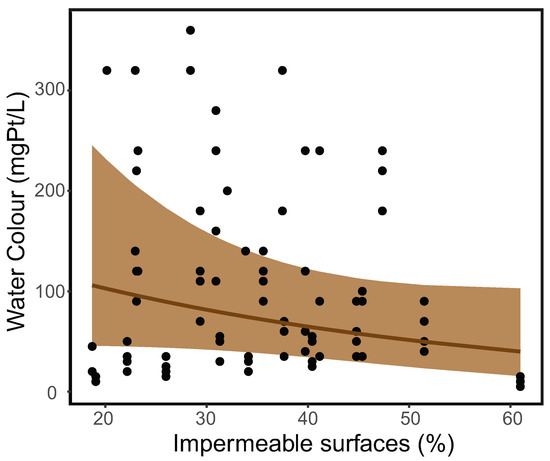
Figure 1
Open AccessArticle
Enzymatic Activity of Soil on the Occurrence of the Endangered Beetle Cheilotoma musciformis (Coleoptera: Chrysomelidae) in Xerothermic Grasslands
by
Barbara Futa, Mariusz Kulik, Łukasz Kajtoch, Miłosz A. Mazur, Małgorzata Jaźwa, Radosław Ścibior and Justyna Wielgos
Insects 2024, 15(5), 307; https://doi.org/10.3390/insects15050307 - 25 Apr 2024
Abstract
This work attempts to find the reasons for the rather limited range of occurrence of Cheilotoma musciformis in Poland, based on soil properties, which affects both the plant cover and the entomofauna. The aim of the study was to assess the influence of
[...] Read more.
This work attempts to find the reasons for the rather limited range of occurrence of Cheilotoma musciformis in Poland, based on soil properties, which affects both the plant cover and the entomofauna. The aim of the study was to assess the influence of soil enzyme activity on the occurrence of Ch. musciformis in xerothermic grasslands in Southern Poland. The sites inhabited by the beetle were most often extensively grazed by farm animals or had recently been cleared of bushes. The control plots were in wasteland. The soils of most sites with Ch. musciformis were characterized by significantly higher activity of the tested enzymes and higher content of total organic carbon and total nitrogen, as well as lower pHKCl compared to the control sites. The higher enzymatic activity of soils in sites with the beetle than in the control sites may indicate the dependence of the occurrence of this beetle on the presence of patches of extensively grazed xerothermic grasslands. Grazing influences the behavior of preferred host plant species. Therefore, when planning active protection of xerothermic grasslands inhabited by Ch. musciformis, changes in the biochemical properties of the soil and vegetation structure should be taken into account.
Full article
(This article belongs to the Section Insect Ecology, Diversity and Conservation)
►▼
Show Figures
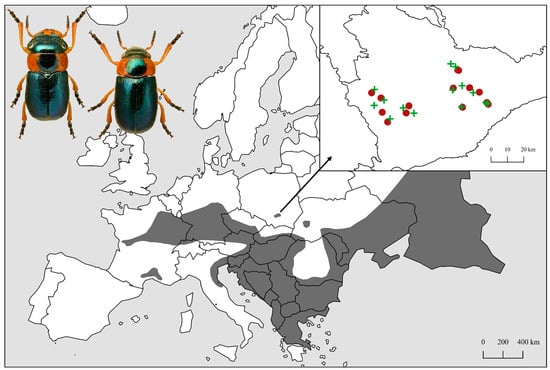
Figure 1
Open AccessReview
Edible Insects in Slavic Culture: Between Tradition and Disgust
by
Agnieszka Orkusz and Martyna Orkusz
Insects 2024, 15(5), 306; https://doi.org/10.3390/insects15050306 - 25 Apr 2024
Abstract
Insects are a conventional food in many cultures worldwide. Why therefore are they treated with aversion by the majority of people in Western countries? The aim of this work is to understand cultural norms and historical practices related to insects that can explain
[...] Read more.
Insects are a conventional food in many cultures worldwide. Why therefore are they treated with aversion by the majority of people in Western countries? The aim of this work is to understand cultural norms and historical practices related to insects that can explain why in the countries of the West it is so difficult to accept them as a foodstuff, and why the disgust that they arouse is more common than in other regions of the world. Insects in Western countries are associated with negative experiences resulting from cultural and religious beliefs, traditions, stories, myths and individual experiences. Although there are species of insect that have positive associations, the high number of negative terms popularized the negative image of these creatures in people’s minds, as a result of which the concept of insects as a foodstuff arouses disgust in the culture of the West. Understanding the aversion to insects will contribute to the broader understanding of consumer attitudes, cultural influences on consumption, or potential shifts in food choices. It also can help develop strategies or methods that will assist in changing this reluctance and encourage the utilization of insects as a food source.
Full article
(This article belongs to the Collection Cultural Entomology: Our Love-hate Relationship with Insects)
►▼
Show Figures
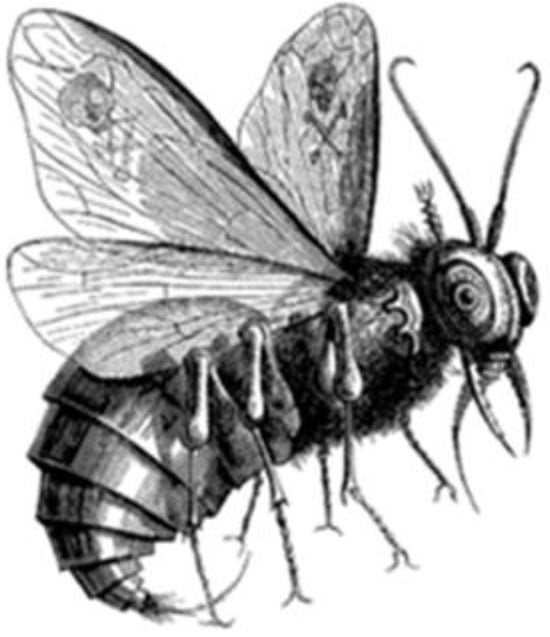
Figure 1
Open AccessArticle
Expanded Geographical Distribution of Coleomegilla maculata lengi (Coleoptera: Coccinellidae) in North America
by
Louis Hesler and Mathew Brust
Insects 2024, 15(5), 305; https://doi.org/10.3390/insects15050305 - 25 Apr 2024
Abstract
Several species of lady beetle native to North America have declined in abundance in the last few decades, often accompanied by contractions in their geographic ranges. Coleomegilla maculata lengi is a lady beetle native to North America that is an important predator of
[...] Read more.
Several species of lady beetle native to North America have declined in abundance in the last few decades, often accompanied by contractions in their geographic ranges. Coleomegilla maculata lengi is a lady beetle native to North America that is an important predator of pests in various agroecosystems. Its reported range spans the eastern half of the USA, with no sustained decline in abundance or contraction of its range reported. Indeed, we recently collected several individuals of this lady beetle in central USA roughly 500 km beyond the western edge of its reputed range. We hypothesized that new records could indicate either that previous range characterization failed to include pre-existing collection records further west or that C. maculata lengi has recently expanded its geographic range. To test these hypotheses, we searched several institutional insect collections and digital databases for records and found many earlier records of C. maculata lengi beyond its reputed geographic range, clearly showing that the previous characterization of its geographic distribution in North America was substantially underestimated. In addition, we report a new state record of C. maculata lengi from Wyoming, USA, that further indicates its geographic range expansion in North America. We discuss new records of C. maculata lengi in light of declines in native coccinelline lady beetle species in North America.
Full article
(This article belongs to the Special Issue Diversity and Abundance of Predators and Parasitoids of Insect Pests)
►▼
Show Figures

Figure 1
Open AccessArticle
Gut Microbiota Affects Host Fitness of Fall Armyworm Feeding on Different Food Types
by
Lin Ma, Daotong Wang, Qilin Ren, Jiaqi Sun, Lei Zhang, Yunxia Cheng and Xingfu Jiang
Insects 2024, 15(5), 304; https://doi.org/10.3390/insects15050304 - 24 Apr 2024
Abstract
The fall armyworm (FAW), Spodoptera frugiperda, seriously threatens food and cash crops. Maize, wheat, and even rice damage by FAWs have been reported in many areas of China. It is urgent to clarify the mechanism which FAWs adapt to different feeding hosts
[...] Read more.
The fall armyworm (FAW), Spodoptera frugiperda, seriously threatens food and cash crops. Maize, wheat, and even rice damage by FAWs have been reported in many areas of China. It is urgent to clarify the mechanism which FAWs adapt to different feeding hosts and develop effective control technologies. Two-sex life tables and 16s rDNA sequencing were used to determine the host fitness and gut microbial diversity of FAWs when fed four different food types. Considering the life history parameters, pupa weight, and nutrient utilization indexes, the host fitness of FAWs when fed different food types changed in descending order as follows: artificial diet, maize, wheat, and rice. The gut microbial composition and the diversity of FAWs when fed different food types were significantly different, and those changes were driven by low-abundant bacteria. The gut microbes of FAWs that were fed with maize had the highest diversity. The functions of the gut microbes with significant abundance differences were enriched in nutrient and vitamin metabolism and other pathways that were closely related to host adaptation. Furthermore, we identified five genera (Acinetobacter, Variovorax, Pseudomonas, Bacillus, and Serratia) and one genus (Rahnella) that were positively and negatively correlated with the host fitness, respectively. This study revealed the possible role of gut microbes in the host adaptation of FAWs.
Full article
(This article belongs to the Section Insect Pest and Vector Management)
Open AccessBrief Report
Characterisation of a Novel Insect-Specific Virus Discovered in Rice Thrips, Haplothrips aculeatus
by
Hao Hong, Zhuangxin Ye, Gang Lu, Kehui Feng, Mei Zhang, Xiaohui Sun, Zhilei Han, Shanshan Jiang, Bin Wu, Xiao Yin, Shuai Xu, Junmin Li and Xiangqi Xin
Insects 2024, 15(5), 303; https://doi.org/10.3390/insects15050303 - 24 Apr 2024
Abstract
Insects constitute the largest proportion of animals on Earth and act as significant reservoirs and vectors in disease transmission. Rice thrips (Haplothrips aculeatus, family Phlaeothripidae) are one of the most common pests in agriculture. In this study, the full genome sequence of
[...] Read more.
Insects constitute the largest proportion of animals on Earth and act as significant reservoirs and vectors in disease transmission. Rice thrips (Haplothrips aculeatus, family Phlaeothripidae) are one of the most common pests in agriculture. In this study, the full genome sequence of a novel Ollusvirus, provisionally named “Rice thrips ollusvirus 1” (RTOV1), was elucidated using transcriptome sequencing and the rapid amplification of cDNA ends (RACE). A homology search and phylogenetic tree analysis revealed that the newly identified virus is a member of the family Aliusviridae (order Jingchuvirales). The genome of RTOV1 contains four predicted open reading frames (ORFs), including a polymerase protein (L, 7590 nt), a glycoprotein (G, 4206 nt), a nucleocapsid protein (N, 2415 nt) and a small protein of unknown function (291 nt). All of the ORFs are encoded by the complementary genome, suggesting that the virus is a negative-stranded RNA virus. Phylogenetic analysis using polymerase sequences suggested that RTOV1 was closely related to ollusvirus 1. Deep small RNA sequencing analysis reveals a significant accumulation of small RNAs derived from RTOV1, indicating that the virus replicated in the insect. According to our understanding, this is the first report of an Ollusvirus identified in a member of the insect family Phlaeothripidae. The characterisation and discovery of RTOV1 is a significant contribution to the understanding of Ollusvirus diversity in insects.
Full article
(This article belongs to the Section Insect Behavior and Pathology)
►▼
Show Figures
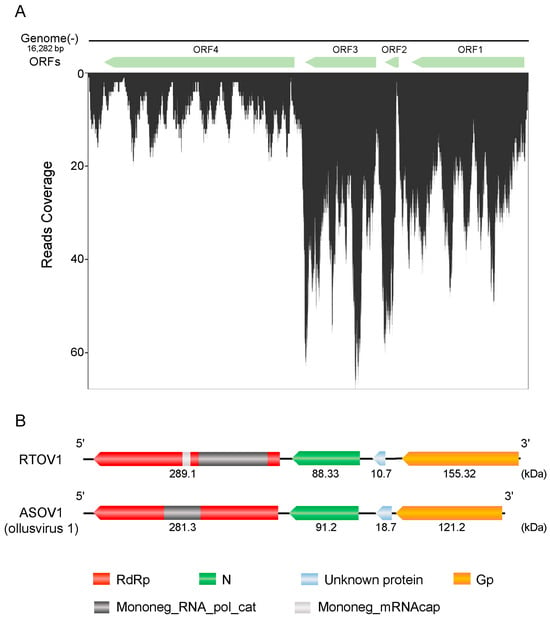
Figure 1
Open AccessArticle
The Synergistic Effect of Lemongrass Essential Oil and Flometoquin, Flonicamid, and Sulfoxaflor on Bemisia tabaci (Genn.) (Hemiptera: Aleyrodidae): Insights into Toxicity, Biochemical Impact, and Molecular Docking
by
Moataz A. M. Moustafa, Fatma S. Ahmed, Nawal Abdulaziz Alfuhaid, Nourhan A. El-Said, El-Desoky S. Ibrahim and Mona Awad
Insects 2024, 15(5), 302; https://doi.org/10.3390/insects15050302 - 24 Apr 2024
Abstract
The whitefly, Bemisia tabaci (Genn.), is one of the most dangerous polyphagous pests in the world. Eco-friendly compounds and new chemical insecticides have gained recognition for whitefly control. In this study, the toxicity and biochemical impact of flometoquin, flonicamid, and sulfoxaflor, alone or
[...] Read more.
The whitefly, Bemisia tabaci (Genn.), is one of the most dangerous polyphagous pests in the world. Eco-friendly compounds and new chemical insecticides have gained recognition for whitefly control. In this study, the toxicity and biochemical impact of flometoquin, flonicamid, and sulfoxaflor, alone or combined with lemongrass essential oil (EO), against B. tabaci was studied. In addition, a molecular docking study was conducted to assess the binding affinity of the tested compounds to AchE. Based on the LC values, the descending order of the toxicity of the tested compounds to B. tabaci adults was as follows: sulfoxaflor > flonicamid > flometoquin > lemongrass EO. The binary mixtures of each of the tested compounds with lemongrass EO exhibited synergism in all combinations, with observed mortalities ranging from 15.09 to 22.94% higher than expected for an additive effect. Sulfoxaflor and flonicamid, alone or in combination with lemongrass EO, significantly inhibited AchE activity while only flonicamid demonstrated a significant impact on α-esterase, and none of the tested compounds affected cytochrome P450 or GST. However, the specific activity of P450 was significantly inhibited by the lemongrass/sulfoxaflor mixture while α-esterase activity was significantly inhibited by the lemongrass/flometoquin mixture. Moreover, the lemongrass EO and all the tested insecticides exhibited significant binding affinity to AchE with energy scores ranging from −4.69 to −7.06 kcal/mol. The current findings provide a foundation for utilizing combinations of essential oils and insecticides in the integrated pest management (IPM) of B. tabaci.
Full article
(This article belongs to the Special Issue Chemical Toxicology and Insecticide Resistance on Insect Pests)
►▼
Show Figures
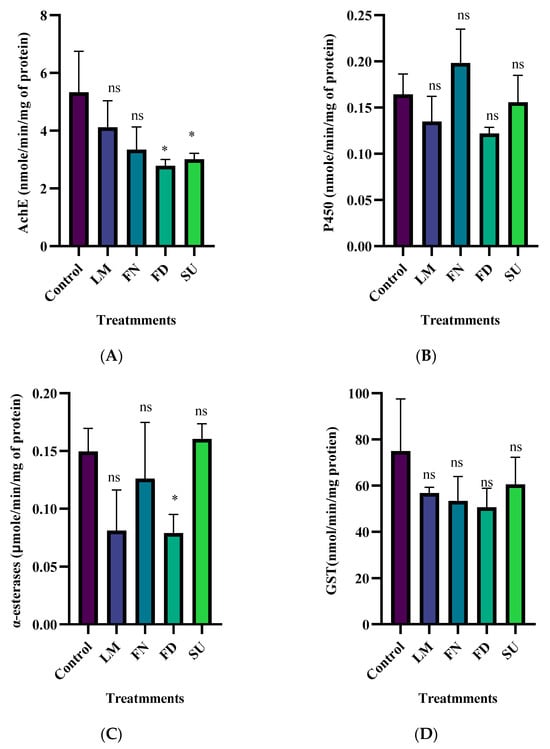
Figure 1
Open AccessArticle
Population Dynamics of Fall Armyworm (Lepidoptera: Noctuidae) in Maize Fields in Uganda
by
Angella Lowra Ajam, Jeninah Karungi, Geofrey Ogwal, Stella Aropet Adumo, Pamela Paparu and Michael Hilary Otim
Insects 2024, 15(5), 301; https://doi.org/10.3390/insects15050301 - 23 Apr 2024
Abstract
Spodoptera frugiperda (Lepidoptera: Noctuidae), commonly known as fall armyworm, was first detected in Uganda in 2016 and has spread to all the maize-growing districts. Different methods have been deployed to control this pest. However, there is a limited understanding of the role of
[...] Read more.
Spodoptera frugiperda (Lepidoptera: Noctuidae), commonly known as fall armyworm, was first detected in Uganda in 2016 and has spread to all the maize-growing districts. Different methods have been deployed to control this pest. However, there is a limited understanding of the role of the environment and farmers’ practices on the abundance of and damage by S. frugiperda in Uganda. This study, therefore, assessed the abundance of S. frugiperda and leaf damage levels in three different districts and explored the association between agronomic practices, crop phenology, and weather parameters on S. frugiperda damage and abundance in smallholder farmers’ maize fields using a longitudinal monitoring survey in 69 farmers’ fields of Kole, Kiryandongo, and Nakaseke for three seasons. The numbers of egg masses and adults were generally low. The highest numbers of adults were trapped in Kiryandongo, followed by Nakaseke, and the lowest numbers were trapped in Kole. Leaf damage and incidence of damaged plants differed significantly between districts and seasons. Leaf damage and abundance of larvae varied significantly in the districts and at different growth stages. Conservation tillage, reduced weeding frequency, increased rainfall and high maximum temperatures were associated with reduced S. frugiperda damage. No significant relationship was observed between pesticide or cropping systems with S. frugiperda leaf damage. However, the influence of fertilizer use on leaf damage was contradictory across seasons and districts. Timely and vigilant scouting, proper timing of control measures, and minimum tillage practices should be included in an IPM strategy for S. frugiperda.
Full article
(This article belongs to the Section Insect Pest and Vector Management)
►▼
Show Figures

Figure 1
Open AccessArticle
Host Volatiles Potentially Drive Two Evolutionarily Related Weevils to Select Different Grains
by
Shaohua Lu, Lingfang Zhang, Yujie Lu, Mingshun Chen and Zhengyan Wang
Insects 2024, 15(5), 300; https://doi.org/10.3390/insects15050300 - 23 Apr 2024
Abstract
The Sitophilus zeamais (maize weevil) and Sitophilus oryzae (rice weevil) are two insect pests that have caused huge economic losses to stored grains worldwide. It is urgent to develop an environmentally friendly strategy for the control of these destructive pests. Here, the olfactory-mediated
[...] Read more.
The Sitophilus zeamais (maize weevil) and Sitophilus oryzae (rice weevil) are two insect pests that have caused huge economic losses to stored grains worldwide. It is urgent to develop an environmentally friendly strategy for the control of these destructive pests. Here, the olfactory-mediated selection preference of the two weevil species to three stored grains was analyzed, which should help establish a pull–push system in managing them. Bioassays showed that maize weevil adults prefer to select maize, followed by paddy and wheat, while rice weevil adults mainly migrate towards wheat. Volatile analyses revealed that 2-ethylhexanol, piperitone, and (+)-Δ-cadiene are the major components in volatiles from both maize and wheat, but the abundance of these chemicals is much lower in maize than that in wheat. The volatile limonene was only detected in paddy. Y-tube bioassays suggest that 2-ethylhexanol, piperitone, and (+)-Δ-cadiene were all attractive to both weevils, whereas limonene was attractive only to rice weevils. Overall, maize weevil appeared more sensitive to the tested volatiles based on having much lower effective concentrations of these volatiles needed to attract them. The differences in volatile profiles among the grains and the sensitivity of the two species towards these volatiles may explain the behavioral differences between maize and rice weevils in selecting host grains. The differences in sensitivity of maize and rice weevils towards host volatile components with abundance differences are likely determinants driving the two insect species to migrate towards different host grains.
Full article
(This article belongs to the Special Issue Advances in Chemical Ecology of Plant–Insect Interactions)
►▼
Show Figures
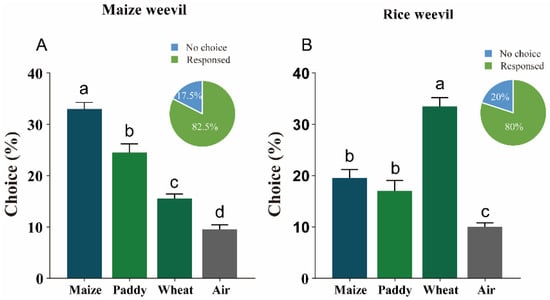
Figure 1
Open AccessArticle
Molecular Correlates of Diapause in Aphidoletes aphidimyza
by
Xiaoyan Dai, Yu Wang, Yan Liu, Ruijuan Wang, Long Su, Zhenjuan Yin, Shan Zhao, Hao Chen, Li Zheng, Xiaolin Dong and Yifan Zhai
Insects 2024, 15(5), 299; https://doi.org/10.3390/insects15050299 - 23 Apr 2024
Abstract
The aphidophagous gall midge, Aphidoletes aphidimyza (Rondani) (Diptera: Cecidomyiidae), a dominant natural enemy of aphids, has been used as a biological control agent in many countries to control aphids in greenhouses. To identify key factors that induce diapause in A. aphidimyza, we
[...] Read more.
The aphidophagous gall midge, Aphidoletes aphidimyza (Rondani) (Diptera: Cecidomyiidae), a dominant natural enemy of aphids, has been used as a biological control agent in many countries to control aphids in greenhouses. To identify key factors that induce diapause in A. aphidimyza, we evaluated the effects of photoperiod and temperature on the incidence of diapause in A. aphidimyza under laboratory conditions. The results showed that temperature and photoperiod had significant impacts on development and diapause in A. aphidimyza. Low temperatures and a short photoperiod inhibited development, while high temperatures and a long photoperiod promoted development. Temperatures above 20 °C and a photoperiod greater than 14 h prevented diapause in A. aphidimyza. However, the highest diapause rate was recorded at under 15 °C and 10L:14D photoperiod conditions. At 15 °C, the first to third larvae were sensitive to a short photoperiod at any stage, and a short photoperiod had a cumulative effect on diapause induction. The longer the larvae received short light exposure, the higher the diapause rate appeared to be. Transcriptome sequencing analysis at different stages of diapause showed that differentially expressed genes were mainly enriched in the glucose metabolism pathway. Physiological and biochemical analyses showed that diapausing A. aphidimyza reduced water content; accumulated glycogen, trehalose, sorbitol, and triglycerides; and gradually reduced trehalose and triglyceride contents in the body with the extension of diapause time. Glycogen may be used as a source of energy, but sorbitol is usually used as a cryoprotectant. This study provided results on aspects of diapause in A. aphidimyza, providing data and theoretical support for promoting its commercial breeding and in-depth research on the molecular mechanisms underlying diapause regulation.
Full article
(This article belongs to the Special Issue Diapause Regulation and Biological Control of Natural Enemy Insects)
►▼
Show Figures
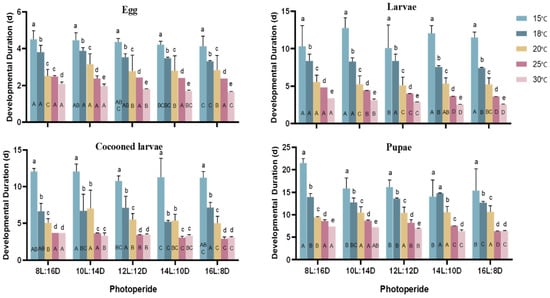
Figure 1
Open AccessArticle
Genetic Diversity and Population Structure of the Invasive Oriental Fruit Fly, Bactrocera dorsalis (Diptera: Tephritidae) in Burkina Faso
by
Nouhoun Traoré, Mahamadi Kientega, Hamidou Maïga, Karim Nebié, Issaka Zida, Roberto Galizi, Emmanuel Kiendrebeogo, Bazoumana B. D. Sow, Adrien M. G. Belem, Remy A. Dabiré and Abdoulaye Diabaté
Insects 2024, 15(5), 298; https://doi.org/10.3390/insects15050298 - 23 Apr 2024
Abstract
Bactrocera dorsalis Hendel is a highly invasive horticultural pest that is of major economic importance worldwide. In Burkina Faso, it is one of the main insect pests that affects the production and exportation of mangos. Understanding the biology and the genetic dynamics of
[...] Read more.
Bactrocera dorsalis Hendel is a highly invasive horticultural pest that is of major economic importance worldwide. In Burkina Faso, it is one of the main insect pests that affects the production and exportation of mangos. Understanding the biology and the genetic dynamics of this insect pest provides crucial information for the development of effective control measures. The aim of this study was to understand the distribution, diversity, and genetic structure of B. dorsalis in Burkina Faso. Male flies were collected transversally in Burkina Faso and analyzed by PCR using 10 microsatellite markers. The results showed an abundance of B. dorsalis varying from 87 to 2986 flies per trap per day at the different sampling sites. The genetic diversity was high at all sites, with an average Shannon’s Information Index (I) of 0.72 per site. The gene flow was high between study populations and ranged from 10.62 to 27.53 migrants. Bayesian admixture analysis showed no evidence of structure, while Discriminant Analysis of Principal Components identified three weakly separated clusters in the population of B. dorsalis in Burkina Faso. The results of this study could be used to optimize the effectiveness of current control interventions and to guide the implementation of new, innovative, and sustainable strategies.
Full article
(This article belongs to the Special Issue Genetics and Ecological Evolution of Dipteran Pest Species)
►▼
Show Figures
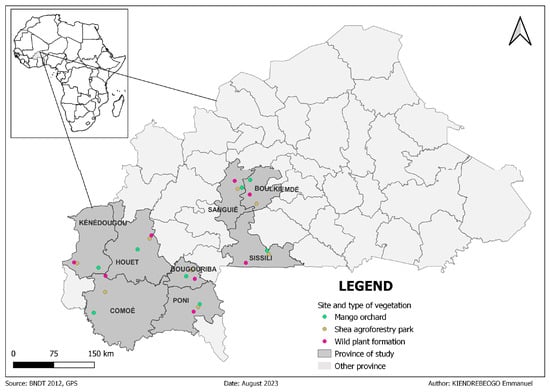
Figure 1
Open AccessArticle
Olfactory Responses of Asproparthenis punctiventris Germar to Leaf Odours of Amaranthaceae Plants
by
Elisabeth H. Koschier, Lena Dittmann and Bernhard Spangl
Insects 2024, 15(4), 297; https://doi.org/10.3390/insects15040297 - 22 Apr 2024
Abstract
Understanding the stimuli used by insect pests to find their food plants can be a first step towards manipulating their behaviour and, thus, controlling them. We investigated the responses of the sugar beet weevil Asproparthenis punctiventris (Coleoptera: Curculionidae) to the volatile leaf odours
[...] Read more.
Understanding the stimuli used by insect pests to find their food plants can be a first step towards manipulating their behaviour and, thus, controlling them. We investigated the responses of the sugar beet weevil Asproparthenis punctiventris (Coleoptera: Curculionidae) to the volatile leaf odours of its food plants, including Beta vulgaris subsp. vulgaris (Altissima and Cicla groups), Atriplex hortensis, Chenopodium album, and Amaranthus retroflexus, in a four-arm olfactometer. A bioassay procedure was developed, and the frequency of visits and time spent by adult weevils in the quadrant of the olfactometer with leaf volatiles was recorded, as was their first choice of quadrant. Females and males were equally attracted to the leaf odours of young B. vulgaris subsp. vulgaris plants, i.e., sugar beet and chard, as indicated by the overall picture of the behavioural parameters analysed. Males, but not females, responded positively to the leaf odour of the garden orache (A. hortensis), and no response was observed when the weevils were tested with the leaf odours of fat hen (C. album) or common amaranth (A. retroflexus). These results suggest that A. punctiventris uses leaf odours to locate sugar beet and other food plants. Knowledge of the olfactory responses of this pest can provide a basis for improved monitoring or mass trapping strategies.
Full article
(This article belongs to the Section Insect Pest and Vector Management)
►▼
Show Figures
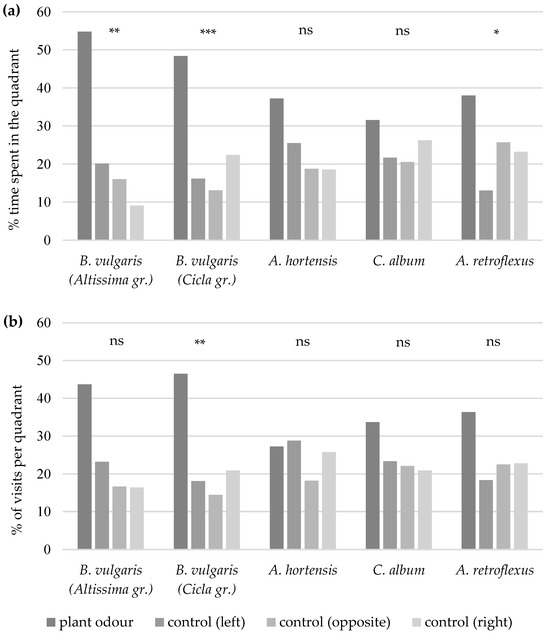
Figure 1
Open AccessArticle
Proteomic Analysis of Salivary Secretions from the Tea Green Leafhopper, Empoasca flavescens Fabrecius
by
Cheng Pan, Xueyi He, Luxia Xia, Kexin Wei, Yuqun Niu and Baoyu Han
Insects 2024, 15(4), 296; https://doi.org/10.3390/insects15040296 - 22 Apr 2024
Abstract
Saliva plays a crucial role in shaping the compatibility of piercing–sucking insects with their host plants. Understanding the complex composition of leafhopper saliva is important for developing effective and eco-friendly control strategies for the tea green leafhopper, Empoasca flavescens Fabrecius, a major piercing–sucking
[...] Read more.
Saliva plays a crucial role in shaping the compatibility of piercing–sucking insects with their host plants. Understanding the complex composition of leafhopper saliva is important for developing effective and eco-friendly control strategies for the tea green leafhopper, Empoasca flavescens Fabrecius, a major piercing–sucking pest in Chinese tea plantations. This study explored the saliva proteins of tea green leafhopper adults using a custom collection device, consisting of two layers of Parafilm stretched over a sucrose diet. A total of 152 proteins were identified using liquid chromatography–tandem mass spectrometry (LC-MS/MS) following the filter-aided sample preparation (FASP). These proteins were categorized into six groups based on their functions, including enzymes, transport proteins, regulatory proteins, cell structure proteins, other proteins, and unknown proteins. Bioinformatics analyses predicted 16 secreted proteins, which were successfully cloned and transcriptionally analyzed across various tissues and developmental stages. Genes encoding putative salivary secretory proteins, including Efmucin1, EfOBP1, EfOBP2, EfOBP3, Efmucin2, low-density lipoprotein receptor-related protein (EfLRP), EFVg1, and EFVg2, exhibited high expressions in salivary gland (SG) tissues and feeding-associated expressions at different developmental stages. These findings shed light on the potential elicitors or effectors mediating the leafhopper feeding and defense responses in tea plants, providing insights into the coevolution of tea plants and leafhoppers. The study’s conclusions open avenues for the development of innovative leafhopper control technologies that reduce the reliance on pesticides in the tea industry.
Full article
(This article belongs to the Section Insect Molecular Biology and Genomics)
►▼
Show Figures
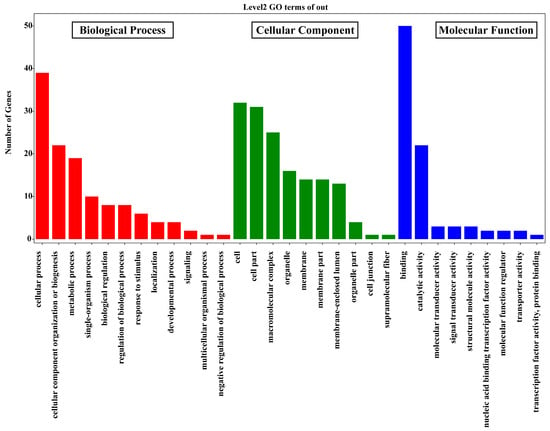
Figure 1
Open AccessBrief Report
Insecticide Resistance in Aedes aegypti Mosquitoes: Possible Detection of kdr F1534C, S989P, and V1016G Triple Mutation in Benin, West Africa
by
Tatchémè Filémon Tokponnon, Razaki Ossè, Sare Dabou Zoulkifilou, Gbenouga Amos, Houessinon Festus, Gounou Idayath, Aboubakar Sidick, Louisa A. Messenger and Martin Akogbeto
Insects 2024, 15(4), 295; https://doi.org/10.3390/insects15040295 - 22 Apr 2024
Abstract
Epidemics of arboviruses in general, and dengue fever in particular, are an increasing threat in areas where Aedes (Ae.) aegypti is present. The effectiveness of chemical control of Ae. aegypti is jeopardized by the increasing frequency of insecticide resistance. The aim of this
[...] Read more.
Epidemics of arboviruses in general, and dengue fever in particular, are an increasing threat in areas where Aedes (Ae.) aegypti is present. The effectiveness of chemical control of Ae. aegypti is jeopardized by the increasing frequency of insecticide resistance. The aim of this study was to determine the susceptibility status of Ae. aegypti to public health insecticides and assess the underlying mechanisms driving insecticide resistance. Ae. aegypti eggs were collected in two study sites in the vicinity of houses for two weeks using gravid Aedes traps (GATs). After rearing the mosquitoes to adulthood, female Ae. aegypti were exposed to diagnostic doses of permethrin, deltamethrin and bendiocarb, using Centers for Disease Control and Prevention (CDC) bottle bioassays. Unexposed, un-engorged female Ae. aegypti were tested individually for mixed-function oxidase (MFO), glutathione-S-transferase (GST) and α and β esterase activities. Finally, allele-specific PCR (AS-PCR) was used to detect possible kdr mutations (F1534C, S989P, and V1016G) in the voltage-gated sodium channel gene in insecticide-exposed Ae. aegypti. Most traps were oviposition positive; 93.2% and 97% of traps contained Ae. aegypti eggs in the 10ème arrondissement of Cotonou and in Godomey-Togoudo, respectively. Insecticide bioassays detected resistance to permethrin and deltamethrin in both study sites and complete susceptibility to bendiocarb. By comparison to the insecticide-susceptible Rockefeller strain, field Ae. aegypti populations had significantly higher levels of GSTs and significantly lower levels of α and β esterases; there was no significant difference between levels of MFOs. AS-PCR genotyping revealed the possible presence of 3 kdr mutations (F1534C, S989P, and V1016G) at high frequencies; 80.9% (228/282) of the Ae. aegypti tested had at least 1 mutation, while the simultaneous presence of all 3 kdr mutations was identified in 13 resistant individuals. Study findings demonstrated phenotypic pyrethroid resistance, the over-expression of key detoxification enzymes, and the possible presence of several kdr mutations in Ae. aegypti populations, emphasizing the urgent need to implement vector control strategies targeting arbovirus vector species in Benin.
Full article
(This article belongs to the Section Medical and Livestock Entomology)
►▼
Show Figures
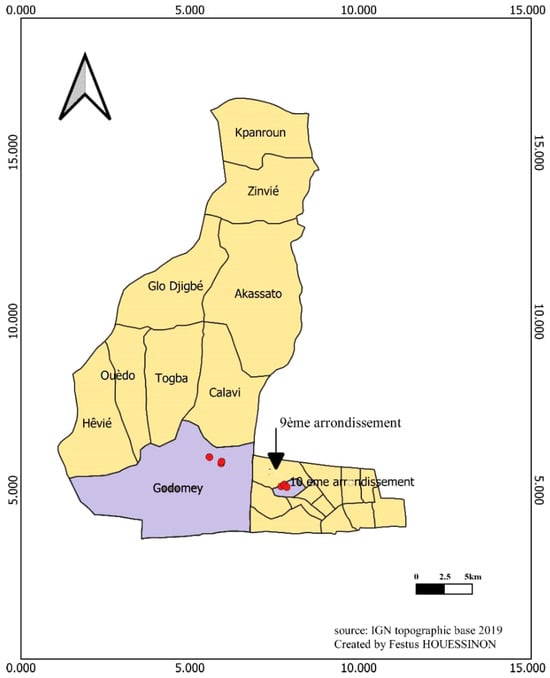
Figure 1

Journal Menu
► ▼ Journal Menu-
- Insects Home
- Aims & Scope
- Editorial Board
- Reviewer Board
- Topical Advisory Panel
- Instructions for Authors
- Special Issues
- Topics
- Sections & Collections
- Article Processing Charge
- Indexing & Archiving
- Editor’s Choice Articles
- Most Cited & Viewed
- Journal Statistics
- Journal History
- Journal Awards
- Conferences
- Editorial Office
Journal Browser
► ▼ Journal BrowserHighly Accessed Articles
Latest Books
E-Mail Alert
News
Topics
Topic in
Agriculture, Animals, Dietetics, Foods, Insects
Edible Insects as Feed and Food: Opportunities and Challenges
Topic Editors: Rifat Ullah Khan, Shabana NazDeadline: 31 July 2024
Topic in
Animals, Arthropoda, Insects, Pathogens, Vaccines, Veterinary Sciences
Ticks and Tick-Borne Pathogens
Topic Editors: Alina Rodriguez-Mallon, Alejandro Cabezas-CruzDeadline: 31 December 2024

Conferences
Special Issues
Special Issue in
Insects
A Commemorative Issue in Appreciation of Professor David L. Denlinger: Great Advances in Insect Physiology
Guest Editors: Geoffrey M. Attardo, Serap Aksoy, Joshua B. BenoitDeadline: 30 April 2024
Special Issue in
Insects
Research in Chemical Ecology of Insects of Significance to Forestry and Agriculture
Guest Editor: Peter MayoDeadline: 15 May 2024
Special Issue in
Insects
Integrated Pest and Pollinator Management (IPPM) in Pollinator-Dependent Crops
Guest Editors: Timothy Leslie, Neelendra K. JoshiDeadline: 31 May 2024
Special Issue in
Insects
Biology and Molecular Mechanisms of Plant-Aphid Interactions
Guest Editor: Yinghua HuangDeadline: 15 June 2024
Topical Collections
Topical Collection in
Insects
Biology and Control of the Invasive Wood-Boring Beetles
Collection Editors: Eiriki Sunamura, Francesco Nugnes, Etsuko Shoda-Kagaya
Topical Collection in
Insects
Improving IPM of Specialty Crop Pests and Global Food Security
Collection Editors: Muhammad Haseeb, Ashfaq Ahmad Sial, Jawwad A. Qureshi, Youichi Kobori
Topical Collection in
Insects
Surveillance Tools and Monitoring Strategies for Native and Exotic Forest Insects
Collection Editors: Davide Rassati, Jon Sweeney, Joseph Francese
Topical Collection in
Insects
The Borderless "Bug" Characterization of Invasive Insect Species: The First Step for Their Control
Collection Editors: Umberto Bernardo, Marco Gebiola




